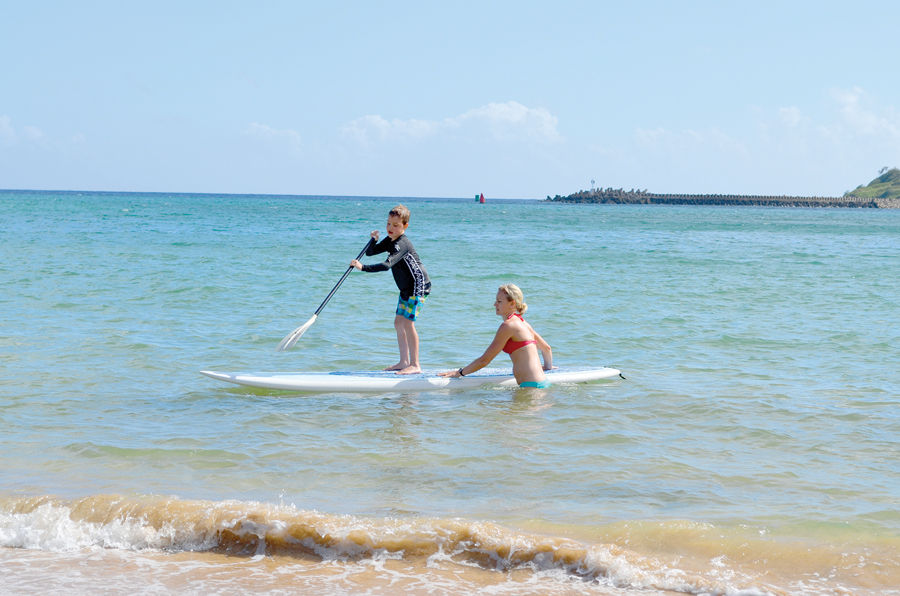LIHUE — Residents and visitors looking to frolic in clean water should, in general, head for the ocean and steer clear of river mouths.
“Our streams, with runoff, are polluted,” said Carl Berg, who leads the Surfrider Foundation Kauai Chapter’s Blue Water Task Force.
This week, Berg released Surfrider’s annual report detailing water quality around the island. Overall, not much has changed from years prior, he said.
“In 2014, Kauai’s ocean beaches and surf breaks were mostly clean, but some were definitely not,” he wrote in the report. “Our streams, with storm water runoff and ground water contamination, are often polluted.”
On Wednesday afternoon, Kermit Mahan, a visitor from Stillwater, Minnesota, could be spotted cooling his feet in Nawiliwili Stream, which flows into Kalapaki Bay and is one of Kauai’s chronically polluted bodies of water. After learning it exceeded state water quality standards 10 of the 11 times it was tested during 2014, Mahan said he was shocked.
“I thought you could practically drink from that stream,” he said, admiring how clear it looked.
Mahan said that, in Minnesota, authorities would be quick to find the pollution’s source and fine those responsible, and that Kauai should be taking steps to address its own problems, including Nawiliwili.
“I’m overwhelmed, given that this is such a delicate ecosystem,” he said.
Water quality data is collected weekly by the state Department of Health at ocean beaches around the island, and monthly samples are collected by Surfrider at surf breaks and streams. Water samples are collected and tested for Enterococcus, an indicator of fecal contamination.
In a 100 ml sample, there should be less than 104 counted bacteria. If the count exceeds 104, the water is considered polluted. The geometric average, or geomean, of five collected samples should not exceed more than 35 bacteria per 100 ml.
During 2014, DOH staff and Surfrider field assistants collected samples from a total of 28 different sites.
Of DOH’s 19 samples sites, five never exceeded the single sample pollution standard, and 15 were polluted less than 10 percent of the time. The two worst DOH test sites were the mouth of the Hanalei River at Weke Road, which was polluted 46.9 percent of the time (down from 54.2 percent last year), and Koloa Landing, polluted 27.3 percent of the time.
“This suggests that pollution is mainly coming from river water,” Berg said.
Hanamaulu Beach was polluted 21.1 percent of the time, down from 60.9 percent during 2012, while the Hanalei Bay Pier site was polluted 16.3 percent.
Scott Bacon is a local dive instructor and founder of Malama Na Apapa, a nonprofit environmental organization. He said that while there have been times when he cancelled dives at Koloa Landing after heavy rain turned the water chocolatey brown, he questioned whether it is really polluted one out of every four days, as the data suggest.
Kalapaki Bay, on the other hand, Bacon considers a different story.
“I do tell people don’t go into the water there … Kalapaki is kind of scary to me,” he said.
In addition to DOH’s efforts, Surfrider collects its own water samples from streams and offshore surf breaks and tests them for bacteria using the same tests used by DOH. Most surf breaks — with the exception of Pakalas — met DOH standards.
Steams, however, not so much.
In 2014, five locations — Waiopili Stream in Mahaulepu, Waikomo Stream at Koloa Landing, Niumalu County Beach Park near Pu‘ali Stream, Hanamaulu Stream and Pakalas surf break — were polluted 100 percent of the time.
Waiopili Stream had the highest geometric average at 9,100.7 bacteria per 100 ml — 260 times the allowable limit — followed by Waikomo Stream at 1,521.5 bacteria and Niumalu Beach Park at 1,257.3.
In an emailed message Wednesday, Watson Okubo, monitoring and analysis section chief of DOH’s Clean Water Branch, thanked Kauai Surfrider for its support in protecting the water recreational stakeholders of Kauai but questioned the accuracy of its findings.
“Understanding the limitations of enterococci in a tropical environment, the data presented by the 2014 Annual Kauai Surfrider report is somewhat misleading,” he wrote.
Okubo said that in an idealistic world, one fecal indicating bacteria may work. In a realistic world, however, he said it does not, and that the use of enterococci and Clostridium perfrigens — a second indicator — is a more accurate way of addressing human fecal contamination.
“Enterococci are found to replicate in the sand,” he wrote. “So enterococci is no ‘silver bullet’ and to make decisions based on enterococci data only would be difficult and/or misleading.”




